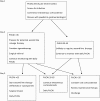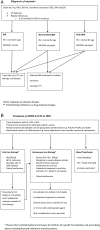Management of ulcerative colitis
- PMID: 26553909
- PMCID: PMC4853583
- DOI: 10.1136/archdischild-2014-307218
Management of ulcerative colitis
Abstract
Ulcerative colitis (UC) in children is increasing. The range of treatments available has also increased too but around 1 in 4 children still require surgery to control their disease. An up-to-date understanding of treatments is essential for all clinicians involved in the care of UC patients to ensure appropriate and timely treatment while minimising the risk of complications and side effects.
Keywords: Gastroenterology; Multidisciplinary team-care; Paediatric Surgery.
Published by the BMJ Publishing Group Limited. For permission to use (where not already granted under a licence) please go to http://www.bmj.com/company/products-services/rights-and-licensing/
Figures



References
-
- Levine A, Koletzko S, Turner D, et al. . The ESPGHAN revised Porto criteria for the diagnosis of inflammatory bowel disease in children and adolescents. J Pediatr Gastroenterol Nutr 2014;58:795–806. - PubMed
Publication types
MeSH terms
Grants and funding
LinkOut - more resources
Full Text Sources
Other Literature Sources
Medical
